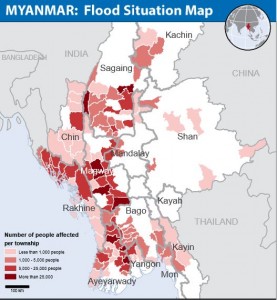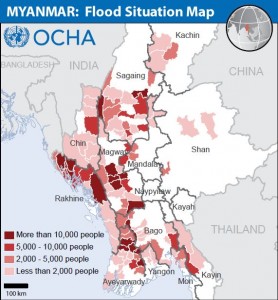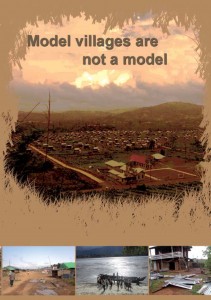Aid (32 found)
Burma Army expansion, abuses along Kokang-China border creating scores of “ghost villages”
Burma Army expansion and ongoing abuses since last year in mountainous areas along the Kokang-China border is making it impossible for tens of thousands of Kokang refugees to return home, according to interviews carried out by SHRF in March 2016 […]
• • •FBR’s relationship with the Burma Government and an Assessment of the Current Situation in Burma
The situation in Burma is changing, in some case for the better and in others for the worse. In the midst of this FBR continues its mission of giving help, hope and love and putting a light on the situation. In areas where there have been improvements, such as parts of Karen State, some of […]
• • •Myanmar: Floods Emergency Situation Report ( No.3)
 As of 10 August, the National Natural Disaster Management Committee (NDMC) reports that over 1.1 million people have been severely affected by floods and landslides since mid-July. This includes a cumulative number of over 240,000 households that have been or remain temporarily displaced during this period […]
As of 10 August, the National Natural Disaster Management Committee (NDMC) reports that over 1.1 million people have been severely affected by floods and landslides since mid-July. This includes a cumulative number of over 240,000 households that have been or remain temporarily displaced during this period […]
Myanmar: Situation Report No.1 – National Natural Disaster Management Committee
Torrential rain starting from 16 July 2015 in the Northern part of Myanmar and Cyclone Komen that landfall Bengladesh has triggered severe and widespread floods and landslides across twelve states and regions in Myanmar […]
• • •Myanmar: Floods Emergency Situation Report ( No.2)
 As of 7 August, the Government of Myanmar’s Relief and Resettlement Department (RRD) reports that close to
As of 7 August, the Government of Myanmar’s Relief and Resettlement Department (RRD) reports that close to
590,000 people have been severely affected by monsoonal floods across 12 of Myanmar’s 14 states and regions
since mid-July. This includes a cumulative number of 122,200 households that have been or remain temporarily
displaced during this period. More than 17 million people live in townships that have been inundated by floods in
July and August, according to RRD. At least 96 people are confirmed to have died in the floods since June.
Burma 2014 Human Rights Report
Burma’s parliamentary government is headed by President Thein Sein. In 2012 the country held largely transparent and inclusive by-elections in which the opposition National League for Democracy (NLD) party, chaired by Aung San Suu Kyi, won 43 of 45 contested seats of a total 664 seats in the legislature. Constitutional provisions grant one-quarter of all national and one-third of all regional and state parliamentary seats to active-duty military appointees and provide that the military indefinitely assume power over all branches of the government should the president declare a national state of emergency. The ruling Union Solidarity and Development Party (USDP) continued to hold an overwhelming majority of the seats in the national parliament and state and regional assemblies, and active-duty military officers continued to wield authority at many levels of government. There is no civilian control of the military; police forces also report to the military through the minister of home affairs […]
• • •At Your Own Risk: Reprisals against Critics of World Bank Financed Projects
 Beginning in February 2015, 40-50 residents of Durgapur village in northern India, mostly women, sat in protest for more than a month. A state-owned company called the Tehri Hydro Development Corporation India Ltd. (THDC) was developing a hydroelectric power project near their community and some villagers believed that tunneling for the project endangered their homes and the overall well-being of their community […]
Beginning in February 2015, 40-50 residents of Durgapur village in northern India, mostly women, sat in protest for more than a month. A state-owned company called the Tehri Hydro Development Corporation India Ltd. (THDC) was developing a hydroelectric power project near their community and some villagers believed that tunneling for the project endangered their homes and the overall well-being of their community […]
UNHCR : Plan of Action-Bay of Bengal and Andaman Sea
 An estimated 63,000 people are believed to have traveled by boat in an irregular and dangerous way in the Bay of Bengal and Andaman Sea in 2014. Another 25,000 joined them in the first quarter of 2015. They are part of a complex, mixed migratory movement composed of refugees, stateless people and economic migrants. Unregulated and, until recently, inconspicuous, the scale of the movement has tripled since 2012 and the level and scale of abuse suffered by voyagers is unprecedented in recent times.
An estimated 63,000 people are believed to have traveled by boat in an irregular and dangerous way in the Bay of Bengal and Andaman Sea in 2014. Another 25,000 joined them in the first quarter of 2015. They are part of a complex, mixed migratory movement composed of refugees, stateless people and economic migrants. Unregulated and, until recently, inconspicuous, the scale of the movement has tripled since 2012 and the level and scale of abuse suffered by voyagers is unprecedented in recent times.
Model Villages Are Not a Model
 This short report by Mungchying Rawt Jat (MRJ) documents cases of farmers who have been forcibly relocated to make way for “development” projects in Kachin State, and are now staying in Sanpya camp in Hugawng Valley, and Aung Myin Thar and Maliyang camps near the Irrawaddy Myitsone.
This short report by Mungchying Rawt Jat (MRJ) documents cases of farmers who have been forcibly relocated to make way for “development” projects in Kachin State, and are now staying in Sanpya camp in Hugawng Valley, and Aung Myin Thar and Maliyang camps near the Irrawaddy Myitsone.
Myanmar’s Moment: Unique Opportunities, Major Challenges
Myanmar is a highly unusual but promising prospect for businesses and investors—an underdeveloped economy with many advantages, in the heart of the world’s fastest-growing region. Home to 60 million inhabitants (46 million of working age), this Asian nation has abundant natural resources and is close to a market of half a billion people […]
• • •
 All posts
All posts